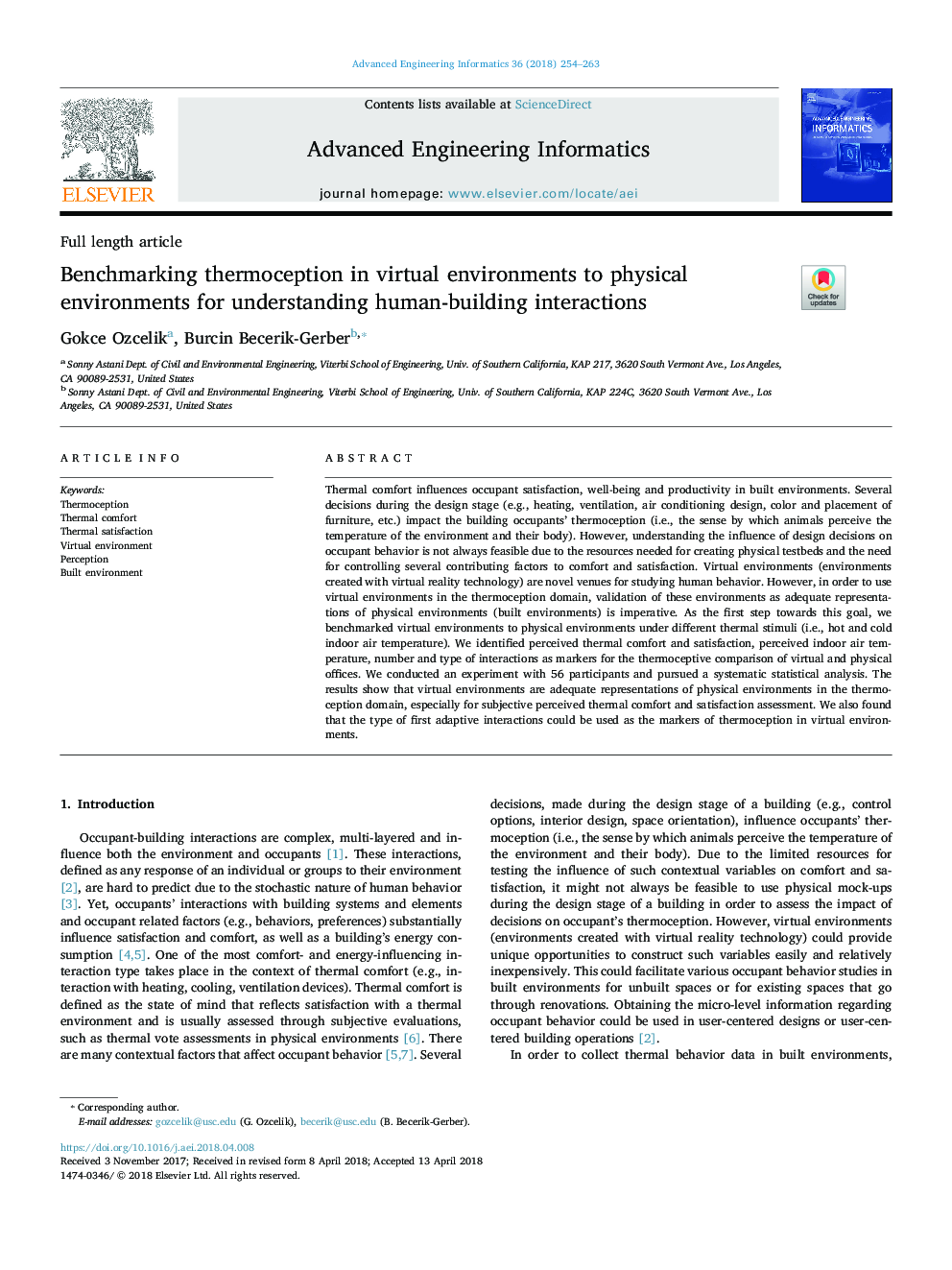| کد مقاله | کد نشریه | سال انتشار | مقاله انگلیسی | نسخه تمام متن |
|---|---|---|---|---|
| 6679597 | 1428033 | 2018 | 10 صفحه PDF | دانلود رایگان |
عنوان انگلیسی مقاله ISI
Benchmarking thermoception in virtual environments to physical environments for understanding human-building interactions
ترجمه فارسی عنوان
ارزیابی گرماسنج در محیط مجازی به محیط فیزیکی برای درک تعاملات ساختمانی انسان
دانلود مقاله + سفارش ترجمه
دانلود مقاله ISI انگلیسی
رایگان برای ایرانیان
کلمات کلیدی
طرز تهیه راحتی حرارتی، رضایت گرمایی، محیط مجازی ادراک، محیط ساخته شده،
ترجمه چکیده
راحتی حرارتی بر رضایت شغلی، رفاه و بهره وری در محیط های ساخته شده تاثیر می گذارد. تصمیمات متعدد در مرحله طراحی (به عنوان مثال، گرما، تهویه، طراحی تهویه مطبوع، رنگ و قرار دادن مبلمان و غیره) بر ترموسیستم ساکنان ساختمان اثر می گذارد (یعنی حسی که دام های دمای محیط و بدن آنها را درک می کنند) . با این حال، درک تاثیر تصمیمات طراحی بر رفتار ساکنان، به دلیل منابع مورد نیاز برای ایجاد تست های فیزیکی و نیاز به کنترل چندین عامل کمک کننده به راحتی و رضایت، همیشه امکان پذیر نمی باشد. محیط های مجازی (محیط هایی که با تکنولوژی واقعیت مجازی ایجاد شده اند) محل های جدیدی برای مطالعه رفتار انسان هستند. با این حال، برای استفاده از محیط های مجازی در حوزه گرماسنج، اعتبار این محیط ها به عنوان نمایش کافی از محیط های فیزیکی (محیط های ساخته شده) ضروری است. به عنوان اولین گام برای رسیدن به این هدف، محیط های مجازی را به محیط فیزیکی تحت محرک های مختلف حرارتی (به عنوان مثال، دمای هوای گرم و سرد) محاسبه کردیم. ما شناسایی راحتی و رضایت حرارتی در نظر گرفته شده، درجه حرارت هوای داخل درک شده، تعداد و نوع تعاملات را به عنوان نشانگرهای مقایسه گرماسنجی دفاتر مجازی و فیزیکی شناسایی کردیم. ما یک آزمایش با 56 شرکت کننده انجام دادیم و یک تحلیل آماری سیستماتیک انجام دادیم. نتایج نشان می دهد که محیط های مجازی بازنمایی کافی از محیط فیزیکی در دامنه گرماگرایی است، به ویژه برای ارزیابی رضایت از نظر حرارتی ذهنی و ارزیابی. همچنین ما دریافتیم که نوع اول تداخلات سازگاری را می توان به عنوان نشانگر ترموسیت در محیط های مجازی استفاده کرد.
موضوعات مرتبط
مهندسی و علوم پایه
مهندسی کامپیوتر
هوش مصنوعی
چکیده انگلیسی
Thermal comfort influences occupant satisfaction, well-being and productivity in built environments. Several decisions during the design stage (e.g., heating, ventilation, air conditioning design, color and placement of furniture, etc.) impact the building occupants' thermoception (i.e., the sense by which animals perceive the temperature of the environment and their body). However, understanding the influence of design decisions on occupant behavior is not always feasible due to the resources needed for creating physical testbeds and the need for controlling several contributing factors to comfort and satisfaction. Virtual environments (environments created with virtual reality technology) are novel venues for studying human behavior. However, in order to use virtual environments in the thermoception domain, validation of these environments as adequate representations of physical environments (built environments) is imperative. As the first step towards this goal, we benchmarked virtual environments to physical environments under different thermal stimuli (i.e., hot and cold indoor air temperature). We identified perceived thermal comfort and satisfaction, perceived indoor air temperature, number and type of interactions as markers for the thermoceptive comparison of virtual and physical offices. We conducted an experiment with 56 participants and pursued a systematic statistical analysis. The results show that virtual environments are adequate representations of physical environments in the thermoception domain, especially for subjective perceived thermal comfort and satisfaction assessment. We also found that the type of first adaptive interactions could be used as the markers of thermoception in virtual environments.
ناشر
Database: Elsevier - ScienceDirect (ساینس دایرکت)
Journal: Advanced Engineering Informatics - Volume 36, April 2018, Pages 254-263
Journal: Advanced Engineering Informatics - Volume 36, April 2018, Pages 254-263
نویسندگان
Gokce Ozcelik, Burcin Becerik-Gerber,
